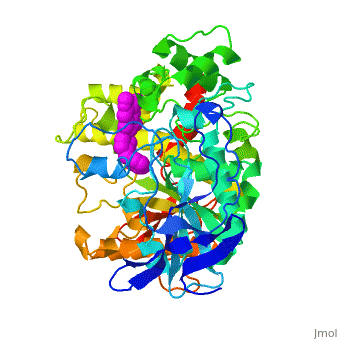Aricept Complexed with Acetylcholinesterase (Italian)
From Proteopedia
(Difference between revisions)
| Line 22: | Line 22: | ||
[[ar:1eve (Arabic)]] | [[ar:1eve (Arabic)]] | ||
[[zh:1eve (Chinese)]] | [[zh:1eve (Chinese)]] | ||
| - | [[de:1eve (German)]] | ||
| - | [[en:1eve]] | ||
| - | [[es:1eve (Spanish)]] | ||
[[fr:1eve (French)]] | [[fr:1eve (French)]] | ||
| - | [[ | + | [[de:1eve (German)]] |
[[ru:1eve (Russian)]] | [[ru:1eve (Russian)]] | ||
| + | [[es:1eve (Spanish)]] | ||
[[tr:1eve (Turkish)]] | [[tr:1eve (Turkish)]] | ||
| + | [[he:1eve (Hebrew)]] | ||
| + | [[en:1eve]] | ||
[[Category: Acetylcholinesterase]] | [[Category: Acetylcholinesterase]] | ||
Revision as of 14:08, 23 March 2015
| |||||||||||
Riferimento
Structure of acetylcholinesterase complexed with E2020 (Aricept): implications for the design of new anti-Alzheimer drugs., Kryger G, Silman I, Sussman JL, Structure. 1999 Mar 15;7(3):297-307. PMID:10368299
See 1eve, 1eve (Chinese), 1eve (Spanish), 1eve (Russian), 1eve (Turkish) & 1eve (French).
Proteopedia Page Contributors and Editors (what is this?)
Jaime Prilusky, Fred Vellieux, Michal Harel, Alexander Berchansky, Eran Hodis, Joel L. Sussman


